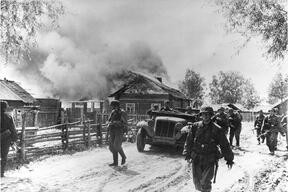- Address:
10 Korotkina Street, Shumilino, Vitebsk Oblast, 211259, Belarus
- Phone:
8 (02130) 4-10-45

Unhealed wounds: new facts about the atrocities of fascists in the Vitebsk region have been revealed
During the period of occupation, at least 52 major punitive operations were carried out on the territory of Vitebsk region, at least 5,179 rural settlements were destroyed and burned, 170 settlements repeated the fate of Khatyn.
According to the official representative of the Prosecutor's Office of the Vitebsk region Daria Kovalenko, to date, over 16,000 people have been interrogated in the Republic of Belarus since April 2021, more than 2.5 thousand of them in the Vitebsk region. More than half of this number of people are prisoners of death camps, relatives, other witnesses and eyewitnesses to the atrocities of the Nazi invaders and collaborators. Most of the interrogations are recorded on video. During the investigation period, over 5,000 inspections of archival documents from places of mass destruction and burial of civilians in rural settlements were carried out, during which archival documents and information were seized, examined and attached to the materials of the criminal case. Only on the territory of the Vitebsk region during the war, at least 105 places of forced detention of civilians were created, and in fact death camps, where a significant number of the population was destroyed by creating unbearable conditions.
During the investigation, information has been established to date on at least 67 previously unknown places of mass burial of civilians, in each of which it is planned to conduct field search operations in order to find the remains of murdered civilians, partisans and underground workers. In 2024, field search operations were carried out in the Vitebsk region in four such places: in Sennenskoye, Postavsky and at two graves in the Polotsk district.
During the period of occupation by the Nazi invaders and their accomplices, at least 52 major punitive operations were carried out on the territory of the region, during which at least 5,179 rural settlements were destroyed (partially or completely destroyed and burned) along with civilians. Based on the evidence obtained during the investigation of the criminal case, the list of villages in the Vitebsk region that repeated the fate of Khatyn increased by 60 and now amounts to 170 settlements (we are talking about those villages that were completely destroyed during the war, at least 50 civilians died, and which did not revive after the war).
Active work continues in the republic to inspect archival documents in order to identify fascist accomplices and criminals who did not receive deserved punishment for crimes against the Belarusian people. Thus, on March 18, 2024, the Supreme Court of the Republic of Belarus issued a guilty verdict on the genocide of the Belarusian people against the punisher of the 118th Ukrainian auxiliary police battalion named Katryuk, who participated in the burning of the village of Khatyn, as well as the destruction of other settlements and civilians in the territories of modern Borisovsky, Logoysky, Dokshitsky districts. After the Second World War, the punisher hid in Canada, where he died in 2015. He was not extradited to carry out justice, but nevertheless found guilty.
Also, for crimes committed during the Great Patriotic War, a criminal case is currently being considered in the Supreme Court against the commander of the above-mentioned Smovsky battalion. The investigation of the facts of the genocide of the Belarusian people during the Great Patriotic War is currently ongoing.
During the inspections of archival documents, 417 rural settlements were additionally established on the territory of the region, which were destroyed by the Nazi invaders and their accomplices during the war. This list is being verified by the Republican interdepartmental working group of the National Academy of Sciences.
Photos from open sources.





